Today, Voyager 1 is the most distant spacecraft from Earth, more than 14 billion miles away and continuing on its journey out of our solar system. Forty years ago, it made its closest approach to Saturn. Although it was not the first to explore the giant ringed planet, as the Pioneer 11 spacecraft completed the first flyby in 1979, Voyager carried sophisticated instruments to conduct more in-depth investigations. NASA’s Jet Propulsion Laboratory in Southern California managed the two Voyager spacecraft launched in 1977 to explore Jupiter and Saturn. Voyager 2 went on to investigate Uranus and Neptune as well, taking advantage of a rare planetary alignment that occurs once every 175 years that enabled the spacecraft to use the gravity of one planet to redirect it to the next.
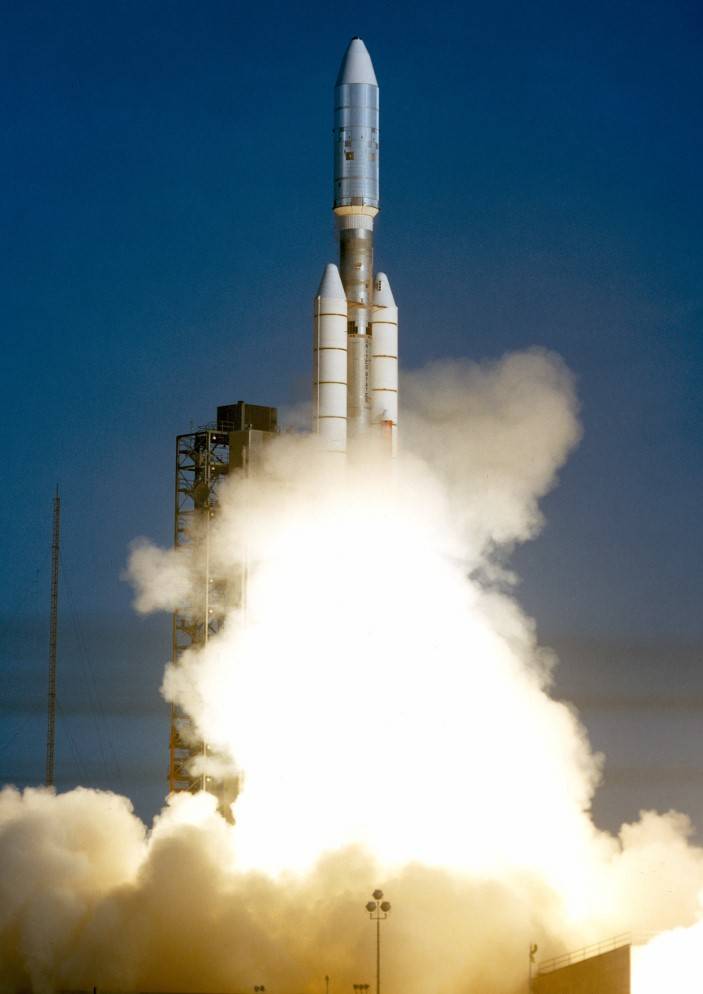
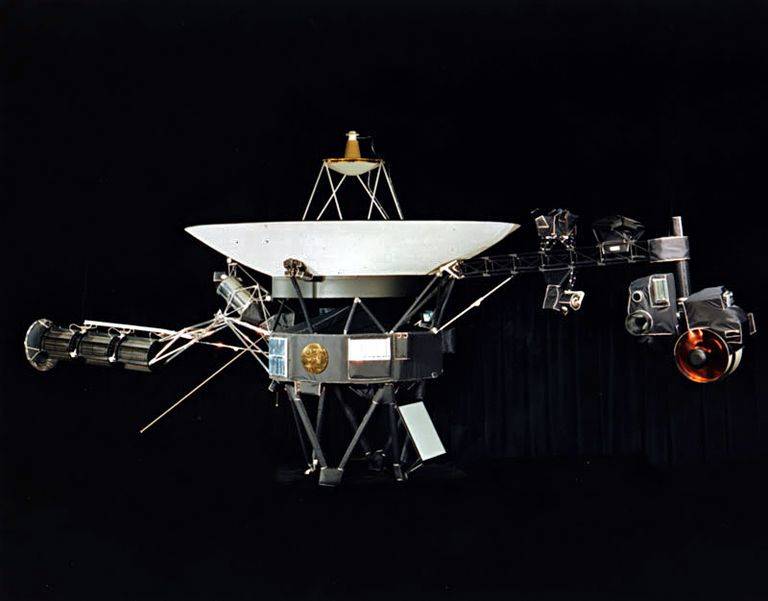
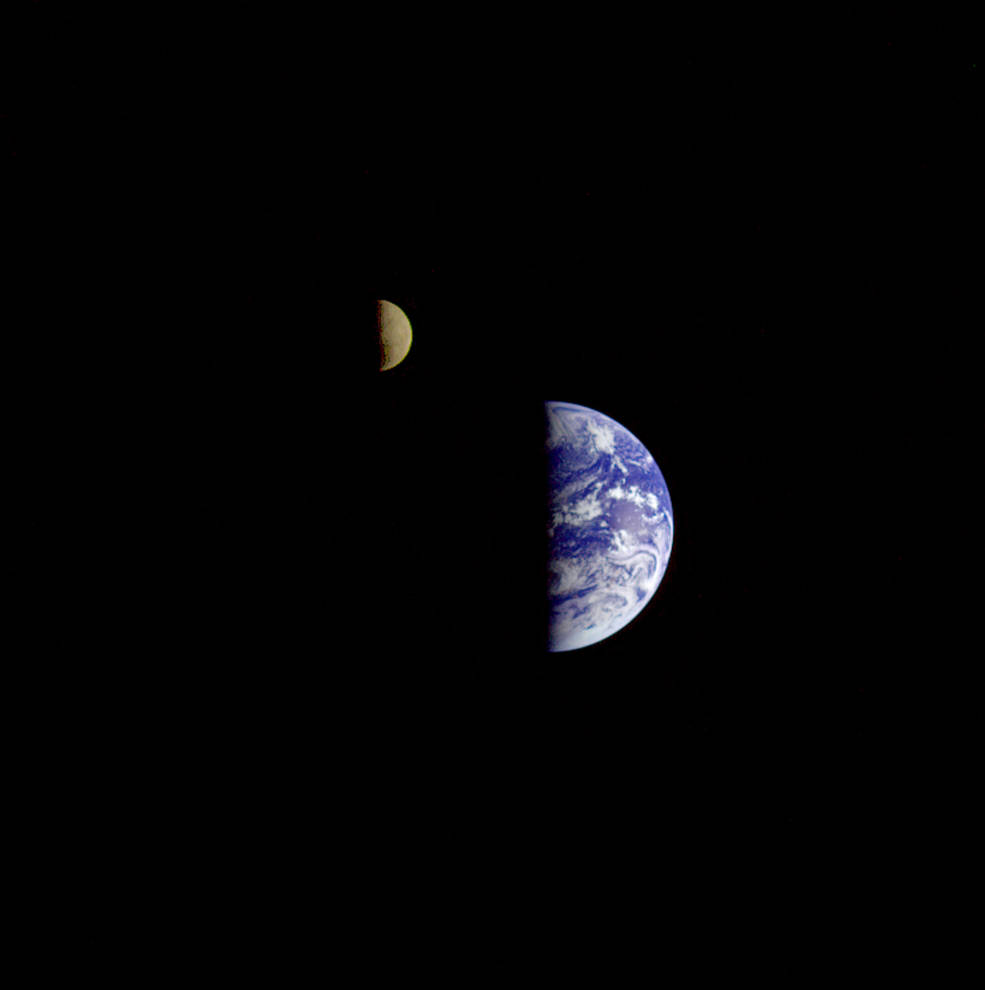
Left: Launch of Voyager 1. Middle: Model of the Voyager spacecraft.
Right: The first single-frame image of the Earth-Moon system, taken by Voyager 1.
To carry out its studies during the planetary encounters as well as while cruising through interplanetary space, Voyager 1 carried a suite of 11 instruments, including:
- an imaging science system consisting of narrow-angle and wide-angle cameras to photograph the planets and their satellites;
- a radio science system to determine the planets’ physical properties;
- an infrared interferometer spectrometer to investigate local and global energy balance and atmospheric composition;
- an ultraviolet spectrometer to measure atmospheric properties;
- a magnetometer to analyze the planets’ magnetic fields and interactions with the solar wind;
- a plasma spectrometer to investigate microscopic properties of plasma ions;
- a low energy charged particle device to measure fluxes and distributions of ions;
- a cosmic ray detection system to determine the origin and behavior of cosmic radiation;
- a planetary radio astronomy investigation to study radio emissions from Jupiter;
- a photopolarimeter to measure the planets’ surface compositions; and
- a plasma wave system to study the planets’ magnetospheres.
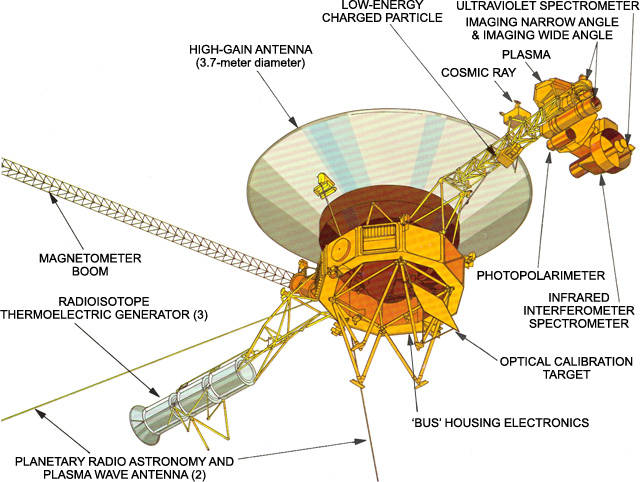
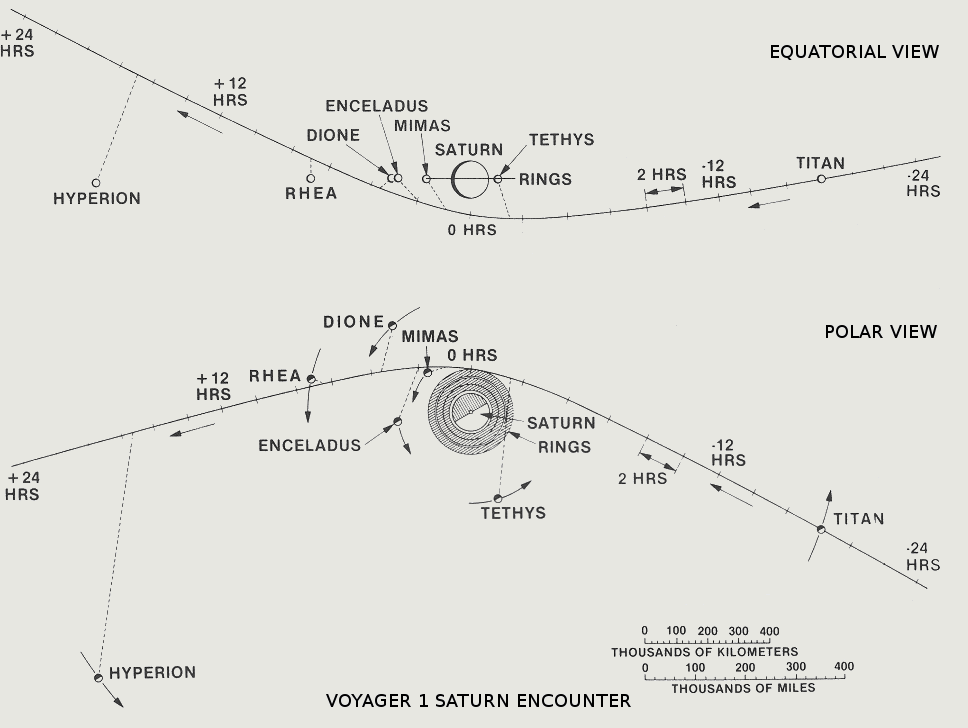
Left: Schematic of the Voyager spacecraft, illustrating the science
instruments. Right: Trajectory of Voyager 1 through the Saturnian system.
Two weeks after its launch from the Cape Canaveral Air Force Station in Florida on Sep. 5, 1977, Voyager 1 turned its cameras back toward its home planet and took the first single-frame image of the Earth-Moon system, providing a taste of future discoveries at the outer planets. The spacecraft crossed the asteroid belt without incident between Dec. 10, 1977, and Sep. 8, 1978, and flew by Jupiter on March 5, 1979. During the four-month encounter, Voyager 1 returned 19,000 photographs of the giant planet, its four largest satellites, discovered two new moons, and found a thin ring encircling Jupiter. The spacecraft’s instruments recorded a wealth of scientific data that greatly expanded our knowledge of the planet. After a 17-month interplanetary cruise, Voyager 1 began its Saturn observations on Aug. 22, 1980, still 68 million miles from the planet. Because of its interest to scientists, mission planners chose the spacecraft’s trajectory to make a close flyby of Saturn’s largest moon Titan, the only planetary satellite with a dense atmosphere, just before the closest approach to the planet itself. This trajectory meant that Voyager 1 would pass over Saturn’s south pole and the gravity assist would send it out of the ecliptic, the plane where the solar system’s planets reside, thus precluding further planetary encounters.
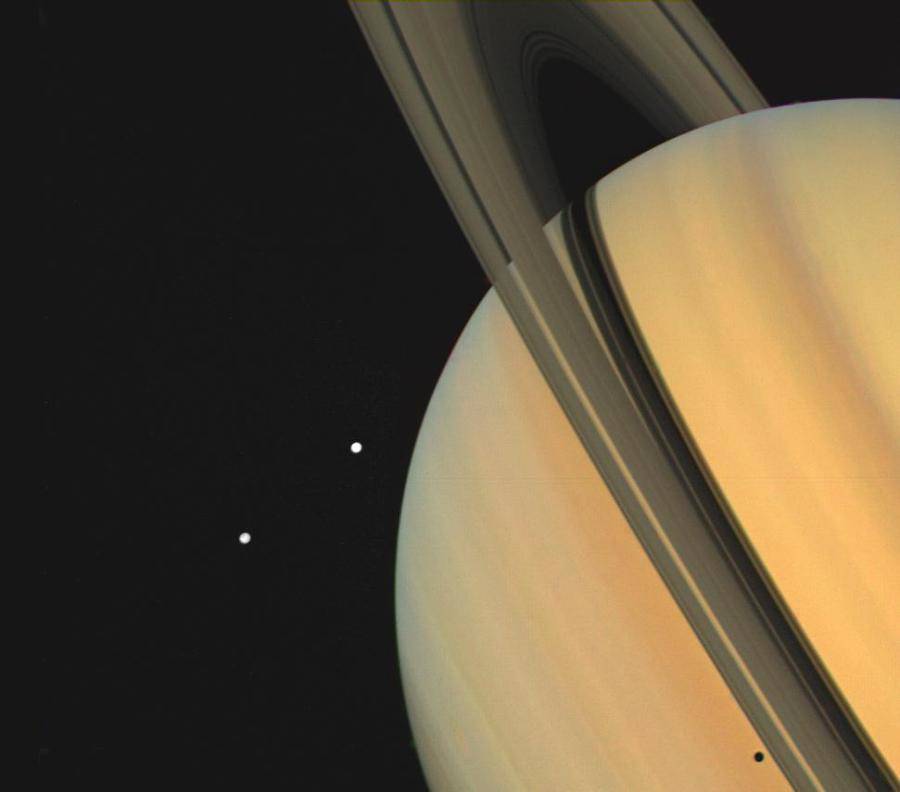
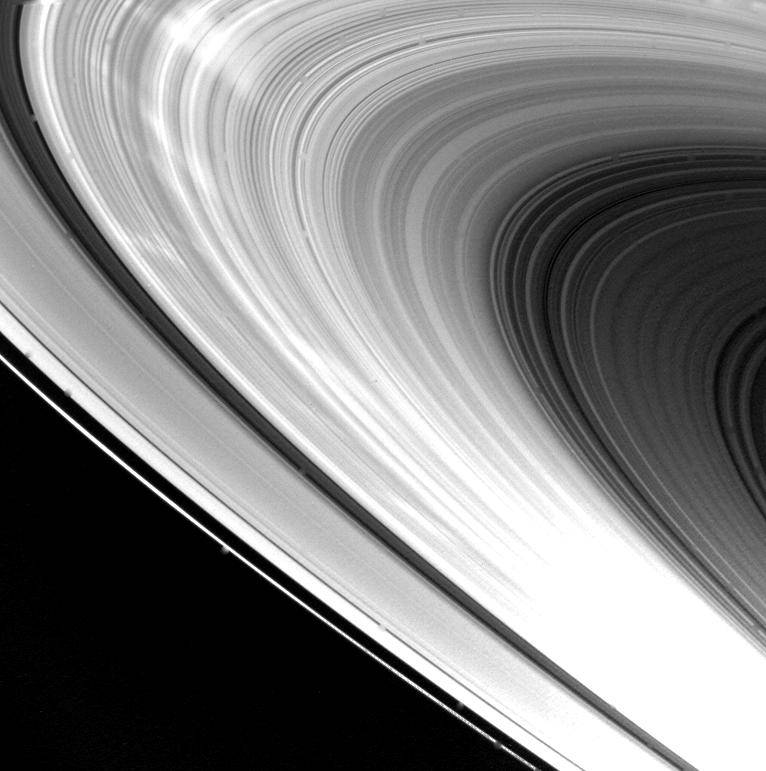
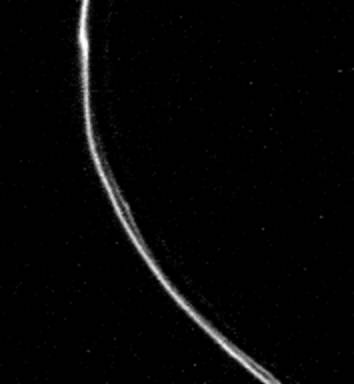
Left: Voyager 1 image of Saturn, its rings, and two of its satellites, Dione, left, and Tethys from eight million miles away. Middle: Voyager 1 image from 446,000 miles away showing details in the planet’srings. Right: Voyager 1 image showing the braided F-ring from 475,000 miles away.
During its approach to Saturn, Voyager 1 returned spectacular images of the planet and ever-more detailed photographs of its rings. These revealed structural features of the various rings, indicating distinctive compositions of each, in particular with regard to particle size. The broad rings easily identifiable from Earth were seen to be composed of thousands of smaller ringlets. Observations of the outer F-ring, discovered by Pioneer 11 the previous year, showed it to have a braided pattern, its small particles perturbed by two newly discovered co-orbiting shepherd moons. Images of Saturn’s atmosphere showed it to be more dynamic than previously expected. Voyager’s instruments indicated that the planet’s atmosphere is composed mainly of hydrogen, with about 11% helium and traces of other gases. The spacecraft observed wind velocities of up 1,100 miles per hour and precisely measured the planet’s rotation at 10 hours and 39.4 minutes.
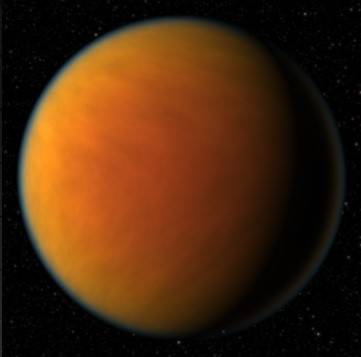
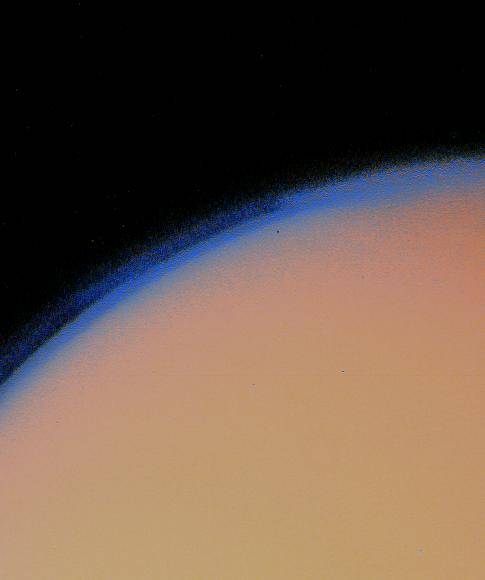
Left: Voyager 1 image of Titan, showing it enveloped in an opaque orange haze of nitrogen and methane. Right: Close-up view of haze layers in Titan’s upper atmosphere.
On Nov. 12, about 18 hours before making its closest encounter with Saturn, Voyager 1 turned its attention to one of the high-priority science targets of the encounter, Titan, passing within 4,034 miles of the planet’s largest moon. The spacecraft’s cameras observed an orange haze obscuring the planet’s surface, with detached haze layers up to 300 miles above the thicker atmosphere. The instruments measured the atmospheric composition at the surface as mostly nitrogen with about 10% methane and traces of hydrocarbons, the pressure at the surface 60% greater than Earth’s mean sea level pressure, and surface temperatures around 93 K (-293 degrees Fahrenheit). Voyager 1 measured Titan’s diameter at 3,194 miles and determined its density indicated a composition of roughly equal proportions of rock and water ice. The spacecraft then made its closest approach of 78,000 miles to Saturn’s cloud tops, swung behind the planet, and began its outbound journey. Saturn’s gravity imparted enough acceleration on Voyager 1 that it achieved escape velocity from the solar system.
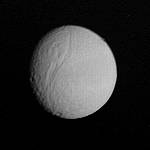
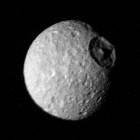
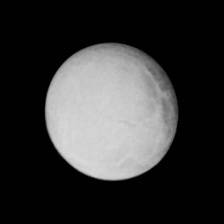
Voyager 1 views of three of Saturn’s icy moons: Tethys, left, Mimas, and Enceladus.
Voyager 1 studied many of Saturn’s smaller icy moons during the encounter and discovered three new ones, bringing the total number of known satellites at the time to 15. In order of study during the encounter and the closest distance to the spacecraft, these moons were: Tethys (258,340 miles), Mimas (54,965 miles), Enceladus (125,570 miles), Dione (100,000 miles), Rhea (45,980 miles), and Hyperion (547,200 miles). These moons range in size from 950 miles in diameter for Rhea to 180-mile-wide Hyperion. Voyager also observed 900-mile-wide outer icy moon Iapetus from a distance of 1.5 million miles. These moons are composed of a mixture of ice and rock, and most show heavily cratered surfaces with the exception of Enceladus. Iapetus displays two very different hemispheres, a dark leading side, and a much brighter trailing side, while the unique surface feature on Mimas is a large crater one-third the diameter of the moon itself.
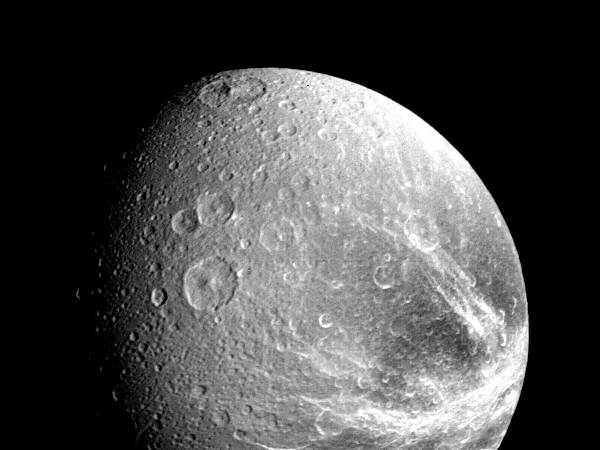
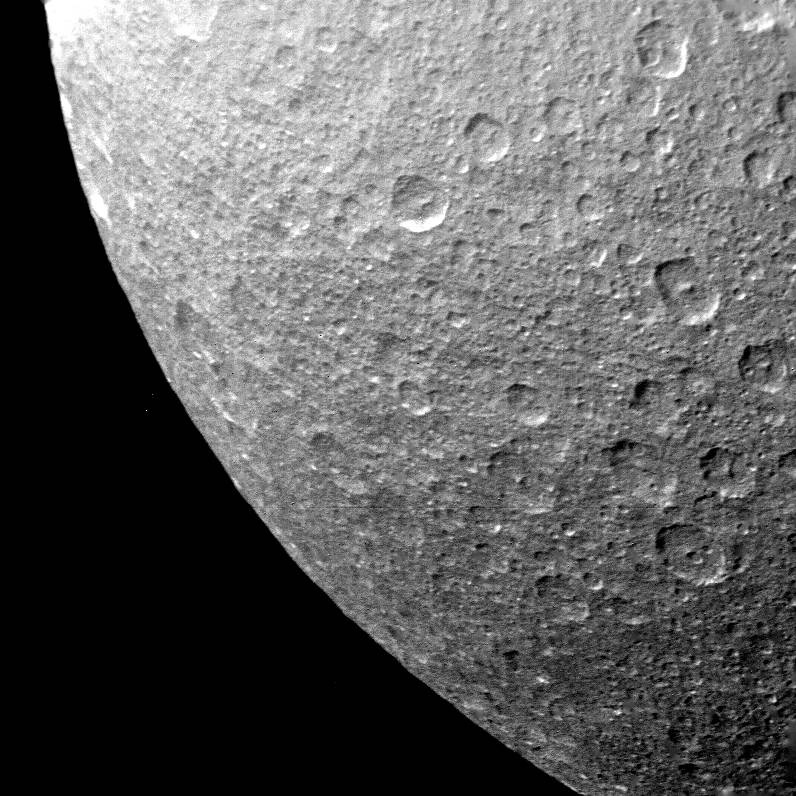
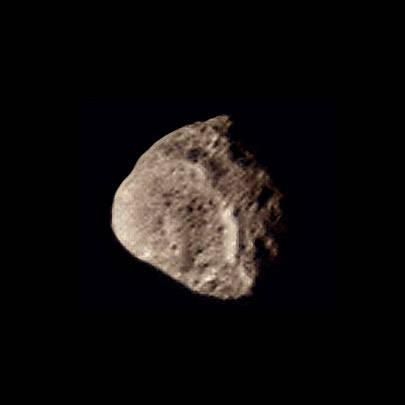
Voyager 1 views of three of Saturn’s icy moons: Dione, left, Rhea, and Hyperion.
Four days after its closest approach, the spacecraft took a magnificent image of Saturn and its rings from a perspective never seen from Earth, the planet in a crescent phase with its night side dimly illuminated by ring-shine, sunlight reflected from the rings. Voyager 1 completed its observations of the Saturn system on Dec. 14, 1980.
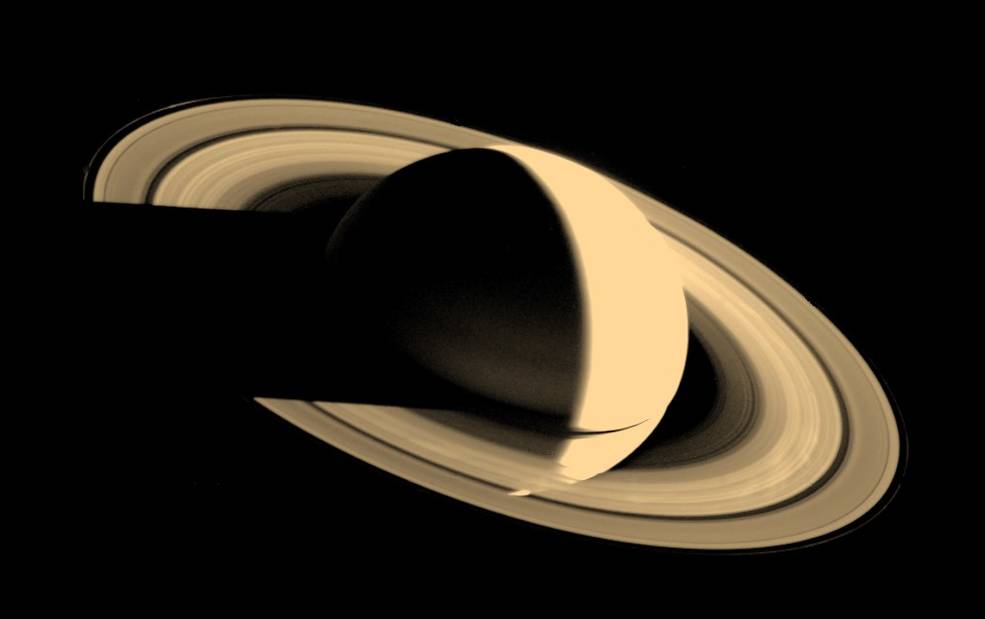
Voyager 1 image of Saturn taken four days after the closest approach and from 3.3 million miles away.
On Feb. 14, 1990, more than 12 years after it began its journey from Earth and shortly before its cameras were permanently turned off to conserve power, Voyager 1 spun around and pointed them back into the solar system. In a mosaic of 60 images, it captured a “family portrait” of six of the solar system’s planets, including a pale blue dot called Earth more than 3.7 billion miles away. Fittingly, these were the last pictures returned from either Voyager spacecraft. In February 2020, to commemorate the photograph’s 30th anniversary, NASA released a remastered version of the image of Earth as Pale Blue Dot Revisited.

Voyager 1’s family portrait of six planets taken on Feb. 14, 1990, when the spacecraft was 3.7 billion miles from Earth.
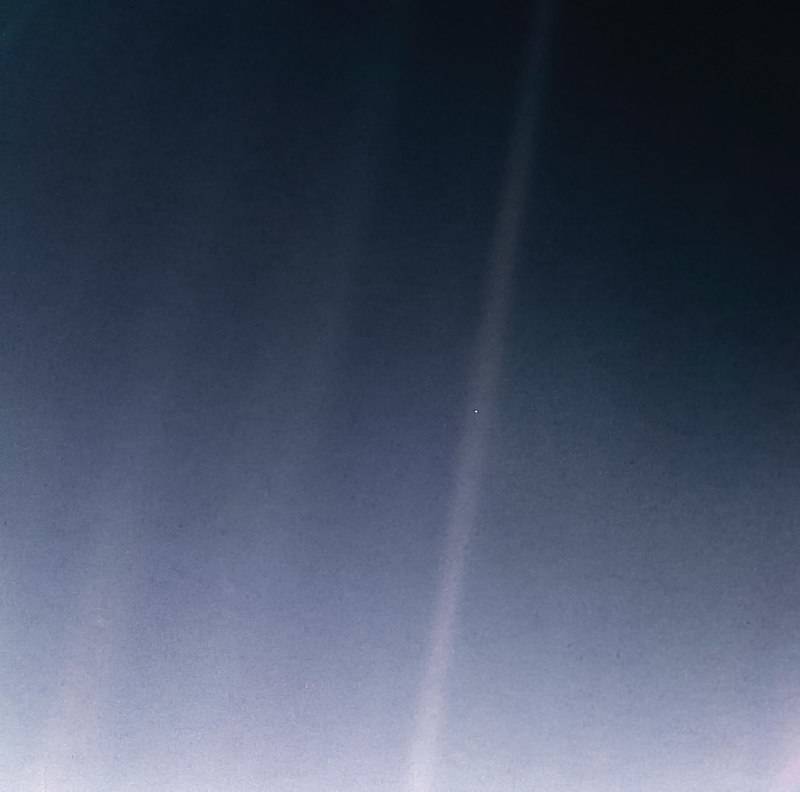
Remastered Voyager 1 photograph of Earth, Pale Blue Dot Revisited, taken from 3.7 billion miles away, released in February 2020. Earth is the tiny point of light near the image’s center.
In August 2012, the spacecraft passed beyond the heliopause, the boundary between the heliosphere, the bubble-like region of space created by the Sun, and the interstellar medium. Now, more than 43 years after its launch, several of Voyager 1’s instruments are still returning useful data about conditions beyond the solar system. Engineers expect that Voyager 1 will continue to return data from interstellar space until about 2025 when it will no longer be able to power its instruments. Just in case an alien intelligence should find it one day, Voyager 1 and its twin carry gold-plated records that contain information about its home planet, including recordings of terrestrial sounds, music, and greetings in 55 languages. Instructions on how to play the record are also included.
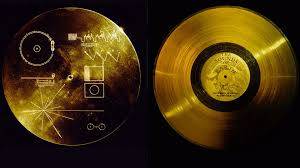
The gold disc carried by each Voyager spacecraft.

























